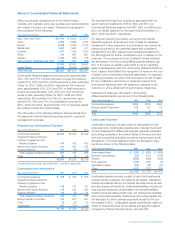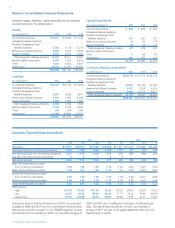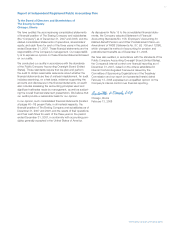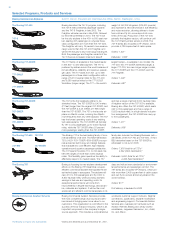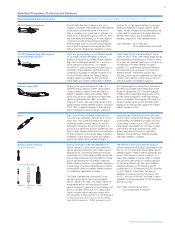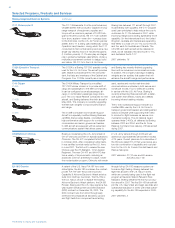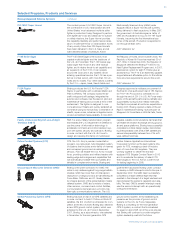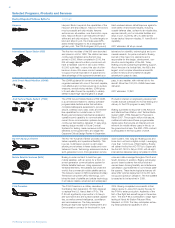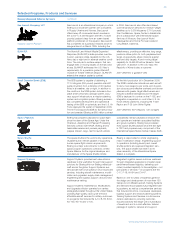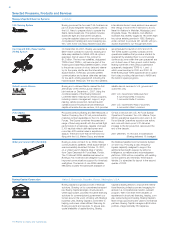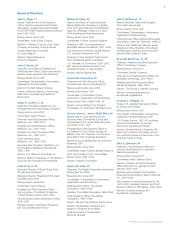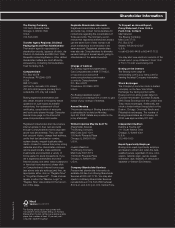Boeing 2007 Annual Report Download - page 87
Download and view the complete annual report
Please find page 87 of the 2007 Boeing annual report below. You can navigate through the pages in the report by either clicking on the pages listed below, or by using the keyword search tool below to find specific information within the annual report.
84
Selected Programs, Products and Services
Boeing Integrated Defense Systems continued
Harpoon Harpoon Block II expands the capabilities of the
Harpoon anti-ship weapon. Harpoon, the world’s
most successful anti-ship missile, features
autonomous, all-weather, over-the-horizon capa-
bility. Harpoon Block II can execute both land-
strike and anti-ship missions. To strike targets on
land and ships in port, the missile uses GPS-
aided inertial navigation to hit a designated tar-
get aim point. The 226.8-kilogram (500-pound)
International Space Station (ISS) The first two modules of the ISS were launched
and joined in orbit in 1998. The station has been
continuously inhabited since the first crew
arrived in 2000. When completed in 2010, the
ISS will weigh almost a million pounds and will
have a habitable volume of 425 cubic meters
(15,000 cubic feet), or about the size of a five-
bedroom home. ISS crews conduct research
to support human exploration of space and to
take advantage of the space environment as a
Joint Direct Attack Munition (JDAM) The JDAM guidance kit converts an existing
unguided warhead into one of the most capable,
cost-effective and combat-proven air-to-surface
weapons, revolutionizing warfare. JDAM gives
U.S. and allied forces the capability to reliably
defeat multiple high-value targets in a single
Joint Tactical Radio System (JTRS) The JTRS Ground Mobile Radios (JTRS GMR)
is a joint service initiative to develop software-
programmable tactical radios that will allow
complete battlespace awareness to provide
secure, wireless voice, data, video and Internet-
like capabilities for mobile forces. In 2007,
Boeing demonstrated multichannel wideband
operations and capability to communicate with
current force communication systems during
continuous field testing; delivered 71 early engi-
neering design models to Future Combat
Systems for testing; made numerous software
deliveries to the government; and began the
Capstone Critical Design Review in December.
KC-767 Advanced Tanker The KC-767 Advanced Tanker provides unrivaled
tanker capability and operational flexibility. This
low-risk, multimission solution is right-sized,
allowing more tankers in fewer bases and more
tankers in the air. Technology advances include a
sixth-generation boom, third-generation remote
Mobile Satellite Ventures (MSV) Boeing is under contract to build two geo-
mobile satellites, with an option for a third, for
a next-generation communications system for
Mobile Satellite Ventures. Using space and
terrestrial elements, the satellites will create the
world’s first commercial mobile satellite service.
The network, based on MSV’s patented Ancillary
Terrestrial Component (ATC) technology, com-
bines the best of satellite and cellular technology.
It will deliver reliable, advanced and widespread
P-8A Poseidon The P-8A Poseidon is a military derivative of
the Boeing Next-Generation 737-800 designed
to replace the U.S. Navy’s fleet of P-3s. The
P-8A will significantly improve the U.S. Navy’s
anti-submarine and anti-surface warfare capabili-
ties, as well as armed intelligence, surveillance
and reconnaissance. The Navy awarded
Boeing an eight-year System Development and
Demonstration contract for the aircraft in June
blast warhead delivers lethal firepower against a
wide variety of land-based targets, including
coastal defense sites, surface-to-air missile sites,
exposed aircraft, port or industrial facilities and
ships in port. Currently, 28 U.S. allied armed
forces deploy Harpoon missiles; 11 have Block II
capability.
2007 deliveries: 48 all-up rounds
laboratory for scientific, technological and com-
mercial research. As prime contractor, Boeing
built all of the major U.S. elements and is
responsible for the design, development, con-
struction and integration of the ISS. Today,
Boeing provides sustaining engineering support.
About the size of a football field, the ISS is the
largest, most complex international scientific
project in history and humankind’s largest
adventure in space to date.
pass, in any weather, with minimal risk to the
aircraft. More than 190,000 JDAMs have been
delivered.
2007 deliveries: 17,843
Production started on engineering development
models that are scheduled for formal testing and
delivery to the FCS program in early 2009.
Boeing submitted its response to the Airborne
and Maritime/Fixed Station Joint Tactical Radio
System (AMF JTRS) Request for Proposal in
March 2007. The program will provide secure,
multiband/multinode software-programmable
digital radios that provide an Internet protocol
network for mobile military users in the air, on
the ground and at sea. The AMF JTRS contract
is anticipated in the first quarter of 2008.
vision system, new wing air refueling pods and
hose drum unit and a digital cockpit. Leveraging
more than 1,000 hours of flight testing, Boeing
will deliver the first two KC-767Js to Japan and
the first KC-767A to Italy in 2008, with all eight
international deliveries being completed in 2009.
voice and data coverage throughout North and
South America. In addition, Boeing will develop
ground-based systems that will provide ad-
vanced beam forming flexibility and interference
cancellation unprecedented in commercial satel-
lite systems. These technological advances will
allow MSV optimal deployment of its ATC tech-
nology and spectrum utilization. The first satellite
is expected to be launched in 2009.
2004. Boeing completed a successful critical
design review in June 2007 paving the way for
the P-8A to enter production. Assembly of the
first of five flight test aircraft began in December
2007. The first P-8A is scheduled to begin flight
testing at Naval Air Station Patuxent River,
Maryland, in 2009. The Navy anticipates achiev-
ing initial operational capability in 2013.
The Boeing Company and Subsidiaries



